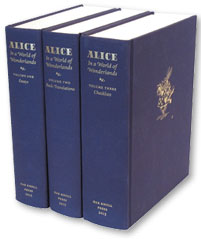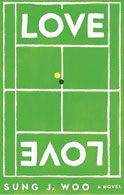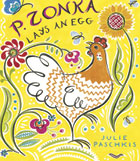Alice in a World of Wonderlands
Jon Lindseth ’56, BME ’57  “‘When I use a word,’ Humpty Dumpty said, in rather a scornful tone, ‘it means just what I choose it to mean—neither more nor less.'” For more than a century, translators around the world have taken this Lewis Carroll quote to heart as they brought his works to an international audience. Alice’s Adventures in Wonderland is one of the most translated books in the world, with editions in 174 languages including Zulu, nine Scots dialects, and Brazilian Sign Language. Carroll never anticipated such far-flung popularity. In 1866, he observed in a letter to his publisher that many considered his book untranslatable, presumably due to its whimsical wordplay. But this summer, on the novel’s 150th anniversary, Oak Knoll Press has released Alice in a World of Wonderlands, a 2,650-page, three-volume set exploring the myriad translations of Carroll’s masterpiece. General editor Jon Lindseth calls the work, which weighs in at just under twenty pounds, “the most extensive analysis ever undertaken examining one English language novel in so many languages.” The former mechanical engineering major worked on the project for six years—designing the format, coordinating its 251 contributors (all unpaid volunteers), editing the text, and writing many of the essays.
“‘When I use a word,’ Humpty Dumpty said, in rather a scornful tone, ‘it means just what I choose it to mean—neither more nor less.'” For more than a century, translators around the world have taken this Lewis Carroll quote to heart as they brought his works to an international audience. Alice’s Adventures in Wonderland is one of the most translated books in the world, with editions in 174 languages including Zulu, nine Scots dialects, and Brazilian Sign Language. Carroll never anticipated such far-flung popularity. In 1866, he observed in a letter to his publisher that many considered his book untranslatable, presumably due to its whimsical wordplay. But this summer, on the novel’s 150th anniversary, Oak Knoll Press has released Alice in a World of Wonderlands, a 2,650-page, three-volume set exploring the myriad translations of Carroll’s masterpiece. General editor Jon Lindseth calls the work, which weighs in at just under twenty pounds, “the most extensive analysis ever undertaken examining one English language novel in so many languages.” The former mechanical engineering major worked on the project for six years—designing the format, coordinating its 251 contributors (all unpaid volunteers), editing the text, and writing many of the essays.

International Alice: Carroll’s classic as published in (below) Georgian, Spanish, Portuguese, Montenegrin, and Urdu
Volume One consists of essays on how Alice fares in each of the 174 languages, as well as on such topics as how the illustrations differ in various editions and how Disney’s film version of Alice was adapted to other languages and cultures. Volume Two takes the same chapter (“A Mad Tea-Party”) in each language and translates it back to English to show the variations of the book across cultures. Volume Three, intended as a scholarly reference tool, is a checklist of the more than 9,000 editions of Alice and its sequel, Through the Looking-Glass. Lindseth’s favorite anecdote from the project can be found in Volume One, in a section on the Australian Aboriginal language Pitjantjatjara. When a government official told an educator that it was pointless to instruct her students in their native tongue since there were no books in the language, the essay notes, “the teacher drew herself up, and with dignity replied, ‘But there are. We have the Bible and Alice in Wonderland‘.
 Second Street Station Lawrence H. Levy ’69
Second Street Station Lawrence H. Levy ’69
In a work of historical fiction based on a true story, a young woman in nineteenth-century New York dreams of defying social norms by becoming a detective—and gets her chance when she finds herself at the murder scene of a prominent politician’s brother. En route to solving the crime, heroine Mary Handley falls in love; meets such historical figures as Thomas Edison, J.P. Morgan, and Nikola Tesla; and discovers that being a detective is more dangerous than she ever imagined. “Readers won’t expect the surprise denouement as Handley steals the show,” Booklist said in a review, “and guarantees readership for a sequel.”
 Love Love Sung J. Woo ’94
Love Love Sung J. Woo ’94
Kirkus described Woo’s work as “a deeply felt novel of parents and children, husbands and wives—the many ways we try to connect and fail; and how sometimes, somehow, we succeed.” The book alternates between the perspectives of adult siblings Judy and Kevin, who are forced to come to terms with their own lives when their father falls gravely ill. After finding out that he isn’t a match to donate a kidney to his dad, Kevin discovers that he was adopted—and the only information he has about his birth mother is a nude centerfold. His journey to learn more leads him out of his calm and orderly life as a tennis instructor and into San Francisco’s seedy adult film industry. Meanwhile, Judy warily begins a new relationship with a mysterious former co-worker.
 P. Zonka Lays an Egg Julie Paschkis ’79
P. Zonka Lays an Egg Julie Paschkis ’79
The value of originality is the underlying lesson of this colorfully illustrated children’s book, about a brood of chickens who spend their days productively laying eggs and suspiciously clucking about the title character, a dreamy sort who prefers to wander and enjoy the world. When the others finally convince our avian heroine to lay an egg, it comes out as colorful as the grass, sky, and flowers she so admires. “She didn’t lay very many eggs,” writes author-illustrator Paschkis, “but the ones she laid were worth the wait.”
 Let There Be Water Seth M. Siegel ’74, JD ’78
Let There Be Water Seth M. Siegel ’74, JD ’78
Although Israel is 60 percent desert and has a fast-growing population, it is not facing a water shortage; in fact, it has a surplus and exports water to neighboring countries. “From the first days of the state,” writes Siegel, a lawyer and member of the Council on Foreign Relations, “careful use of water was a core principle of civil life.” Meanwhile, in much of the world, droughts and social unrest due to a lack of water are becoming more prevalent. In a book designed as a how-to guide for sustainable water policy, Siegel describes an approach that environmental activist Robert F. Kennedy Jr. calls a “blueprint for the planet.”
To purchase these books and others by Cornellians, or to submit your book for possible mention in Cornell Alumni Magazine, go to the “Cornell Authors” tab at cornellalumnimagazine.com.


